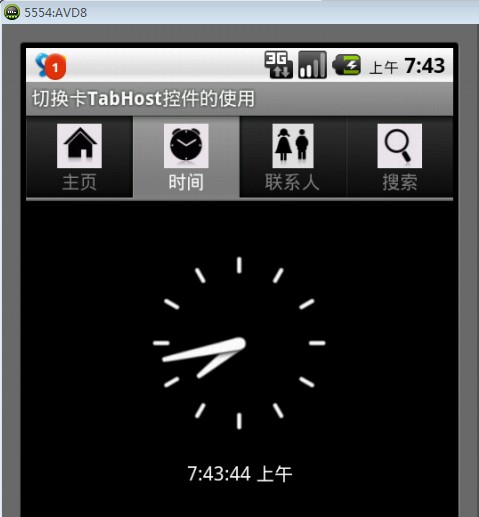2019独角兽企业重金招聘Python工程师标准>>> 
切换卡TabHost控件的使用
在Android中,通常可以使用切换卡(选项卡)实现切换显示不同页面内容的功能。
这一功能可以通过TabHost控件来实现。
下面我们就通过一个简单的实例演示如何使用TabHost控件完成切换卡功能,完成后的运
行效果如图1所示。

图1 主页显示效果
可以看出,在该实例中,总共设置了四个TabHost标签,分别为主页、时间、联系人和搜
索。在点击这些标签时,便可以完成相应页面内容的显示。
1.界面布局
TabHost是整个Tab的容器,是由TabWidget和FrameLayout 两部分组成的。其中
TabWidget是每个tab的标签,而FrameLayout则是tab所要显示的内容。
根据以上的描述,我们就可以对整个显示界面进行合理的布局了。我们以LinearLayout
的垂直布局方式将整个TabHost分成上下两部分,上面使用TabWidget控件显示标签,
下面使用FrameLayout布局显示每个标签下的对应内容。
具体的xml布局文件源码如下:
<?xml version="1.0" encoding="utf-8"?><TabHost xmlns:android="http://schemas.android.com/apk/res/android"android:id="@android:id/tabhost"android:layout_width="match_parent"android:layout_height="match_parent" ><LinearLayout android:orientation="vertical"android:layout_width="match_parent"android:layout_height="match_parent"><!-- TabHost的标签 --><TabWidget android:id="@android:id/tabs"android:layout_width="match_parent"android:layout_height="wrap_content" ></TabWidget><!-- TabHost的内容 --><FrameLayoutandroid:id="@android:id/tabcontent" android:layout_width="match_parent"android:layout_height="match_parent" ><!-- 第一个标签要显示的内容 --><ImageViewandroid:id="@+id/homeimage"android:layout_width="wrap_content"android:layout_height="wrap_content"android:src="@+drawable/homeimage"android:background="#FFFFFF" ></ImageView><!-- 第二个标签要显示的内容 --><LinearLayout android:id="@+id/time"android:layout_width="match_parent"android:layout_height="match_parent"android:orientation="vertical"android:background="#000000"><AnalogClockandroid:layout_marginTop="30dp"android:layout_width="match_parent"android:layout_height="wrap_content" ></AnalogClock><DigitalClockandroid:textColor="#FFFFFF"android:gravity="center_horizontal"android:layout_marginTop="10dp"android:layout_width="match_parent"android:layout_height="wrap_content" ></DigitalClock></LinearLayout> <!-- 第三个标签要显示的内容 --><TextView android:id="@+id/personlist"android:layout_width="match_parent"android:layout_height="match_parent"android:text="联系人列表"></TextView><!-- 第四个标签要显示的内容 --><LinearLayout android:id="@+id/searcher"android:orientation="horizontal"android:layout_width="match_parent"android:layout_height="match_parent" ><EditTextandroid:layout_weight="5"android:layout_width="0dp"android:layout_height="wrap_content"android:hint="请输入搜索关键字" ></EditText><Buttonandroid:layout_weight="1"android:layout_width="0dp"android:layout_height="wrap_content"android:text="搜索"> </Button> </LinearLayout></FrameLayout></LinearLayout></TabHost>通过以上代码可以看出,在FrameLayout布局中分别实现了四个标签下所要显示的内容的布局设置。比如,
在第二个标签“时间”中,我们以LinearLayout的垂直布局方式显示了一个指针式时钟AnalogClock和数字
式时钟DigitalClock,其显示效果如图2所示。
此外,在使用TabHost控件时有一点需要特别注意,TabHost、TabWidget以及
FrameLayout的id是固定的,必须按如下形式进行设置。
1.TabHost的android:id必须设置为:android:id="@android :id/tabhost"
2.TabWidget的android:id必须设置为:android:id="@android :id/tabs"
3.FrameLayout的android:id必须设置为:
android:id="@android :id/tabcontent"

图2 时间显示效果
2.TabHost控件的常用方法
了解了如何对TabHost控件进行布局之后,我们还需要了解TabHost控件的一些常用
方法。具体如下:
public void addTab (TabHost.TabSpec tabSpec); //添加Tabpublic int getCurrentTab (); //获取当前Tab的indexpublic String getCurrentTabTag (); //获取当前Tab的tagpublic View getCurrentTabView (); //获取当前Tab的视图public void setCurrentTab (int index); //设置当前显示哪个Tabpublic void setCurrentTabByTag (String tag); //设置当前显示哪个Tab
3.TabHost.TabSpec
从TabHost控件的常用方法中可以看出,要将Tab加入到TabHost中,需要使用到
addTab (TabHost.TabSpec tabSpec)方法,而这个方法的参数是一个
TabHost.TabSpec对象,那么TabHost的内部类TabHost.TabSpec是用来干嘛的呢?
我们已经知道,每个Tab都是由TabWidget和FrameLayout 两部分组成的。而
TabHost.TabSpec可以为每个Tab设置一个Tag(类型为String),以此来跟踪每一
个Tab。此外,TabHost.TabSpec还可以为Tab设置标签、图标以及内容。由此可以看
出TabHost.TabSpec类对TabHost控件来说是及其重要的。
TabHost.TabSpec类的常用方法如图3所示。

图3 TabHost.TabSpec类的常用方法
由图3可以看出,在TabHost.TabSpec类中提供了设置Tab标签和图标的方法
setIndicator(),以及设置Tab内容的方法setContent()。利用这两个方法,我们便
可以将我们在xml布局文件中定义好的Tab内容加载到对应的TabHost控件中了。具体
实现方法如下:
/** Function : onCreate()* Author : 博客园-依旧淡然*/public void onCreate(Bundle savedInstanceState) {super.onCreate(savedInstanceState);setContentView(R.layout.activity_main);mTabHost = getTabHost(); //获取TabHost对象//添加“主页”Tab到TabHost控件中mTabHost.addTab(mTabHost.newTabSpec("home")//设置Tab标签和图标.setIndicator("主页", getResources().getDrawable(R.drawable.home)).setContent(R.id.homeimage)); //设置Tab内容//添加“时间”Tab到TabHost控件中mTabHost.addTab(mTabHost.newTabSpec("time").setIndicator("时间", getResources().getDrawable(R.drawable.time)).setContent(R.id.time));//添加“联系人”Tab到TabHost控件中mTabHost.addTab(mTabHost.newTabSpec("persons").setIndicator("联系人", getResources().getDrawable(R.drawable.persons)).setContent(R.id.personlist));//添加“搜索”Tab到TabHost控件中mTabHost.addTab(mTabHost.newTabSpec("searcher").setIndicator("搜索", getResources().getDrawable(R.drawable.search)).setContent(R.id.searcher));mTabHost.setBackgroundResource(R.drawable.background); //设置TabHost控件的背景图片mTabHost.setCurrentTab(0); //设置当前显示第一个TabmTabHost.setOnTabChangedListener(this); //设置TabHost控件的事件监听通过以上代码,我们向TabHost控件中添加了四个Tab对象,并设置了各自的Tab标签
和图标以及Tab内容。此外,我们还为TabHost控件设置了背景图片以及默认显示第一
个Tab。
4.事件监听
对TabHost控件进行事件监听,需要实现OnTabChangeListener接口中的
OnTabChanged()方法。
相关资料:
多页显示Tag的使用
http://blog.csdn.net/flowingflying/article/details/6304289
Android应用底部导航栏(选项卡)实例
http://blog.csdn.net/cjjky/article/details/7209056
